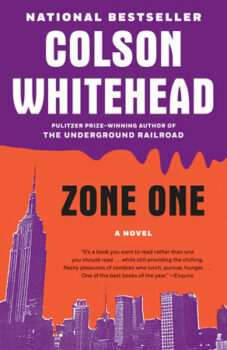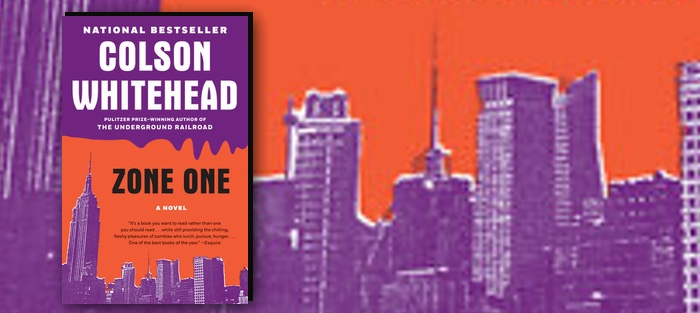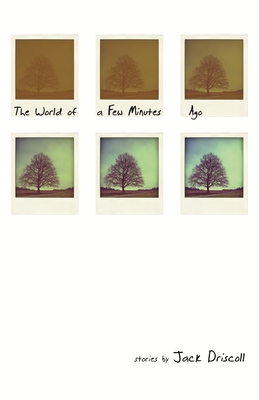Editor’s Note: For the first several months of 2022, we’ll be celebrating some of our favorite work from the last fourteen years in a series of “From the Archives” posts.
In today’s feature, Michael Rudin reviews Colson Whitehead’s novel Zone One. The review was originally published on February 14,2012.
PART I: “If you weren’t concentrating on how to survive the next five minutes, you wouldn’t survive them.”
Welcome to the world of Colson Whitehead’s Zone One (Doubleday, 2011), where a concrete barrier at Broadway and Canal separates Mark Spitz and his fellow men from monsters. In case they get past the guns and bullets, the perched snipers and patrols, there is also armor, a woven-plastic miracle fabric that is the final separation between undead teeth and fresh flesh. That, and consciousness.
Yep, there be zombies out there, creatures infected by a mutating plague that’s only become more potent in the years since “Last Night,” the quiet Sunday evening when society came to its abrupt, bloody end. In the plague’s aftermath, what’s left of the world’s brightest minds have come to reside in Buffalo (Oakland was firebombed, St Augustine nuked, and, well, don’t ask about Birmingham), where they coordinate Manhattan’s resettlement with survivors who have bought into its “American Phoenix” campaign, complete with slogan, anthem, and administrative assistants who give out buttons and hats from the movement’s merchandising arm.
The schwag does little to help the survivors deal with their “vast galaxy of survivor dysfunction,” such as Post-Apocalyptic Stress Disorder (PASD). Nor does company wine or a black-market of painkillers and anti-depressants. Nothing can erase the final memories of friends and loved ones, the moments they went feral and tore into one another. Ditto for the moment the equally gruesome government did, tearing into innocents in early-stage quarantine panics.
No, in the end, Spitz, the Omega Unit he belongs to, and his family of “Pheenie” comrades must concentrate on surviving five-minutes-at-a-time if they are to reclaim the southern tip of the island. It is this real-time, reactionary mindset that provides the perfect narrative module by which to tell Zone One’s story: a Friday, a Saturday, and then a Sunday.
Over one hell of a long weekend, Colson Whitehead unfurls Mark Spitz’s story, squeezing flashbacks between gunfights and requiring that we hang on for the ride if we want to know what came before. Which is exactly right. How else would our narrator share his perceptions on the transformation of his world if not between artillery strikes? Spitz comes to the reader in bite sizes, a direct result of what he’s facing: “… a legion of teeth and fingers.”
 This zombie legion falls into two groups. You already know the “skel,” recognizable from any zombie movie of your youth, or from AMC’s “The Walking Dead.” These are the bloodthirsty ones best to avoid. But leave it to Whitehead—shortlisted for both a Pulitzer and a National Book Award and the recipient of a MacArthur grant—to not only craft an apocalypse where survivors must file Incident Reports, but one where some zombies go for flesh and others freeze in time.
This zombie legion falls into two groups. You already know the “skel,” recognizable from any zombie movie of your youth, or from AMC’s “The Walking Dead.” These are the bloodthirsty ones best to avoid. But leave it to Whitehead—shortlisted for both a Pulitzer and a National Book Award and the recipient of a MacArthur grant—to not only craft an apocalypse where survivors must file Incident Reports, but one where some zombies go for flesh and others freeze in time.
It is this second type of zombie, the “straggler,” that provides Zone One with depth and moral conflict. Whereas skels are walking hunger—muscle memory but no cognition—stragglers don’t walk at all, frozen in some place of their subconscious’ choosing, be it flying a kite, photocopying their buttocks, or reading a palm. They will theoretically do this one act for eternity, allowing Spitz and Omega Unit to muse over what event brought them there in a game called “Solve The Straggler.” When that gets old, they play games with them, be it administering wedgies or drawing on Hitler mustaches. But it’s Whitehead who plays the best game with these “stragglers,” allowing what might be a first in the zombie genre: genuine characterization of that drooling, half-decomposed shell of a monster.
Ironically, the straggler zombie—he who occupies—makes up the one-percent. Given the remaining ninety-nine are after blood and these stragglers aren’t running—on the attack, or, like survivors, from it—an odd affection builds between the unit’s Lieutenant and the undead who have stopped to smell the ash-covered roses. “Personally, I like them,” the Lieutenant remarks. “Not supposed to say it out loud, but I think they’ve got it right and we’re the ninety-nine percent that have it all wrong.”
Nevertheless, the Lieutenant orders Spitz and the other soldiers into a regimented block-by-block “sweep” of Manhattan’s sub-20-story buildings. They must off any remaining stragglers now that the Marines have plugged Manhattan’s subways and bridges from future invasion.
Most zombie stories focus on the survivalist narrative: the running, hiding, screaming defense of oneself or one’s family. And while Zone One certainly flashes back to those moments, be it Spitz’s return from Atlantic City on Last Night, or the years he spent on the run since, the bulk of Whitehead’s novel takes place in a time when it is the survivors who mindlessly patrol for meat, who mindlessly kill anything not like them.
The magic in Whitehead’s horror story is that the survivors may horrify the reader more so than the zombies. Hypnotized and bothering nobody, the stragglers gain your pity, then your sympathy. Along with Spitz, you envision who they were before, what love or memory has them hovering in a state between man and monster.
But “Pop ‘em and drop ‘em” are the orders, and when Spitz understands his work he sees it as “…an act of mercy,” necessary busy-work for the society to come, one in which bleach will be a booming industry and window makers will reap fortunes. In the absence of the typical running and hiding, he and the others have time to consider all the different monstrosities at work: the skel monsters, the possibly-monstrous act of killing harmless stragglers, and then the monster who permitted all of this to happen.
What kind of cruel deity granted a glimpse of the angelic sphere, only to yank it away and condemn you to a monster’s vantage? Sentenced you to observe the world through the sad aperture of the dead, suffer the gross parody of your existence. Outside Zone One, the souls sat trapped in the bleachers, spectators to the travesties committed by their alienated hands.
Through Spitz, Whitehead masterfully develops zombies and survivors equally, personalizing the conflict even as both sides can be at times bereft of personality, surviving on barbaric drive, be it for flesh or future.
And yet, even then, Zone One isn’t about the mission or even the zombie plague. It’s not about the delineation between frozen and feral zombies. It’s not even about the soldiers and how they cope, or don’t, or can’t. It’s about Zone One, New York City, and Spitz’s love of her; how if there’s one place in the world that needed to be reclaimed, it was Manhattan, and how the beginning of the world must start here or at least die trying.
PART II: “New York City in death was very much like New York City in life. It was still hard to get a cab, for example. The main difference was that there were fewer people.”
At the beginning of Zone One, readers learn that Mark Spitz held skyscraper aspirations as a boy, hoping to one day live in the Big Apple. Did he know it would be with an assault rifle? Probably not. But even as a post-apocalyptic New Yorker Pheenie, he honors the same mission as those of the pre-undead era:
Millions of people tended to this magnificent contraption, they lived and sweated and toiled in it, serving the mechanism of metropolis and making it bigger, better, story by glorious story and idea by unlikely idea.
The braniacs in Buffalo numbered Zone One this way for a reason. If they can fix New York, they can fix the world. And in their doggedness for the old domestic life, the soldiers of Zone One actually do something miraculous: though a plague rages out beyond their barrier, old life returns. Poker. Movie nights. Birthday parties. Paperwork. They begin killing time in addition to killing zombies.
In this New New York, rather than get promoted or own a home in the Hamptons, the end-goal is to survive, a calling Spitz believes he was born and bred for. In his own words, Spitz was a “survivalist” from a young age who “…had led a mediocre life exceptional only in the magnitude of its unexceptionality. Now the world was mediocre, rendering him perfect.”
Trained to evade zombies by evading girlfriends, a man whose yearbook designation would have been “Most Likely Not to be Named the Most Likely Anything,” we are given the gift of the perfect post-apocalyptic New Yorker, settling in if only it will allow him. It is through Spitz that we come to realize that modern life may have already been mediocre, zombie-like long before the plague accelerated things. Throughout Omega Unit’s sweeps of Manhattan, Spitz reflects back on the former city’s consumerism and entertainment addiction, those less-homicidal hungers that drove New Yorkers pre-PASD.
As for Spitz’s own drive, it seems the only thing that can slow him down is ash. Mobile Disposal units burn dead stragglers with “uncanny efficiency,” and though some surmise the steady fall of ash has more to do with faraway nuclear fallout than individual cremations, Spitz despises all of it equally. He feels the white flakes “in his lungs, becoming assimilated into his body,” and one can’t help but feel that he is, in ways, channeling another time in New York and Zone One’s history, another apocalyptic moment in which New Yorkers despised ash, “…sullying every edifice and muting the blue sky: the dust of the dead.”
But even then, Spitz is a New Yorker. He doesn’t quit. He pushes away “The Forbidden Thought,” an allusion to the suicides that others turned to when five-more-minutes became one-too-many. The only other Forbidden Thought? That would be to call Zone One a book about zombies.
Alive, dead, and undead, Whitehead’s novel is as much about people in their many forms as the city they are trying to re-inhabit. As Mark Spitz so clearly puts it: “The addresses remained the same and so did the flawed philosophies. It wasn’t anyplace else. It was New York City.”






